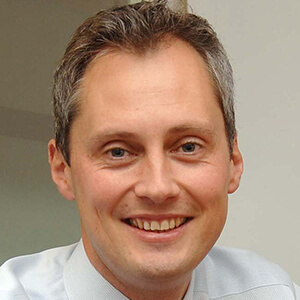Q&A: Clive Morris
Inivata Ltd.
Q: What attracted you to join Inivata and what is your role? Chief Medical Officer, CMO
A: I was attracted to Inivata to help progress a technology I see can make a major impact in improving how we diagnose and manage patients with cancer. The field of liquid biopsy, and ctDNA analysis specifically, is undergoing rapid development and we’re only now beginning to see the potential of what we may be able to achieve with this technology. The opportunity to join a company at the forefront of this revolution and with a platform built on world-class science from a strong academic heritage aligned well with my passion for driving improved patient outcomes. My role at Inivata is to lead the clinical and medical strategies and activities, working closely with colleagues in the laboratory and commercial settings, to ensure we engage in robust and rigorously designed clinical trials to develop clinical data to demonstrate clinical utility and value to patients, their physicians and payors alike.
Q: Why is circulating tumor DNA detection of such great value and how is Inivata helping progress this new technology? What are some of the advantages and potential disadvantages of ctDNA detection?
A: ctDNA analysis and interpretation can bring value to the management of cancer patients in several ways including, most notably, the ability to test in the blood what historically has required much more invasive and costly procedures such as traditional tissue biopsies or even surgical resection to perform. This is potentially a real game changer for cancer management as it allows us to have much greater access to important genomic information that can drive more informed treatment decisions with a goal of providing better care to patients. Some of the settings where this technology could be useful include earlier diagnosis of disease, monitoring of disease, as a staging tool, better treatment choices and even for clinical trial target identification. With all the promise and potential of ctDNA, the hard work is what we are embarking on now which is proving in a clinical setting that these technologies do in fact improve outcomes for patients. We are beginning a series of clinical trials to examine that and look forward to presenting and publishing this data as it matures over time.
Q: Major challenges associated with detecting ctDNA are sensitivity and specificity. What does it take to overcome those challenges and by when can we expect adoption in the clinic?
A: This is a great question and it is absolutely correct that sensitivity and specificity are challenges that need to be met through robust data. It is important to have the right synergies between science, bioinformatics and clinical in order to overcome the challenges of sensitivity and specificity. First, it requires excellent science and a solid, reproducible platform that you can rely on with predictable results to find targets. Then, you must design a robust assay that can perform well against required sensitivity and specificity criteria. Next, you have to prove these claims against a standard which, in the case of ctDNA, would be compared to tissue analysis. Finally, you need to prove that these sensitivity and specificity metrics are clinically relevant. At the end of the day, the combination of these important factors demonstrated in well-designed clinical trials will drive utilization of these technologies in clinic as payor, guideline committees and physicians alike begin to see how to incorporate these into treatment plans for patients.
Q: Additional hurdles exist around the lack of consensus in the technical approach and methodologies used when it comes to choice of sample type, sample storage conditions, sample extraction protocols, and suitable detection techniques. What approach would you suggest so the industry can overcome these challenges?
A: Completely agree. We applaud the work of Dr. Elaine Jeter and her team at MolDx that have put together very specific performance criteria that need to be met by molecular diagnostic laboratories in general and liquid biopsy companies in particular. This will require companies to meet high standard performance criteria in order to achieve reimbursement coverage for their testing platforms. This, along with the work of other groups including the FDA, NY State health department and others will help set standards for the entire industry. Meanwhile, at Inivata, we plan to continue to generate high quality data with our platform which we believe will carry the day over time.
Q: Combined with next-generation sequencing (NGS), liquid biopsy-based tests may be able to address the entire spectrum of cancer treatment from primary diagnosis through remission and recurrence monitoring. What are your thoughts on that?
A: Definitely! We have an active clinical program in each of the areas you have mentioned and others. We look forward to seeing this data mature and will present these findings at up-coming conferences.
Q: Is there anything else you would like to share with someone interested in your field?
A: The industry is ablaze with buzz around liquid biopsies, and we are excited to be part of this revolution. We believe it is important to not allow the enthusiasm to outrun the data. In other words, while incredibly promising, we still need to be disciplined with our science and prove the promise makes a difference clinically. This is what we are focused on at Inivata. Not about making claims or generating buzz for the sake of buzz; but rather about generating evidence to show how to apply the knowledge from ctDNA to improve patients’ lives.
Session Chair Profile
Biography
As an accredited surgeon and proven leader in the biopharmaceutical industry, Clive brings a medical, academic and strong research and development perspective to Inivata, ensuring that the Inivata product line is directed to maximize potential patient benefit. He worked for over a decade in various key roles at AstraZeneca, where he oversaw R&D and medical affairs projects and groups on a global scale, was involved in R&D strategy, investor relations, and most recently led the major transformation of AstraZeneca’s UK strategic R&D sites and global HQ. Clive has extensive experience across all phases of drug development including seven marketed or close-to- market oncology products. He was also the founding Chief Executive of Health Innovation Manchester, an initiative to develop an innovation ecosystem combining industrial and academic sectors with the decentralization of £6bn per annum of health and social care services. He’s accredited as a Pharmaceutical Medicine specialist by the UK Royal College of Physicians, as well as holding an Executive MBA and Honorary Professorship of Translational Medicine at the University of Manchester.
Talk
The Future of ctDNA
What are some of the exciting areas in MRD, monitoring, stratification, etc. How can ctDNA transform cancer management?




